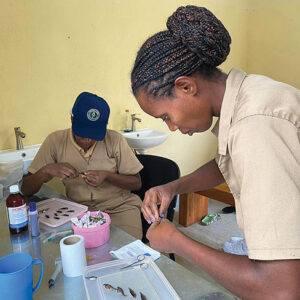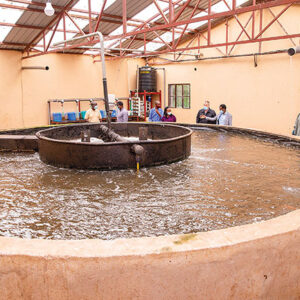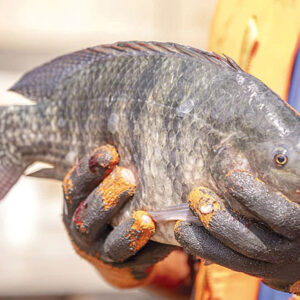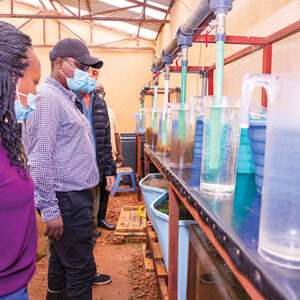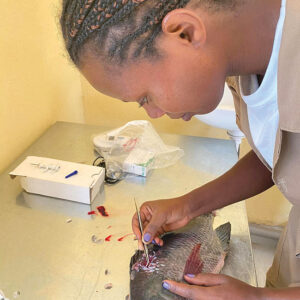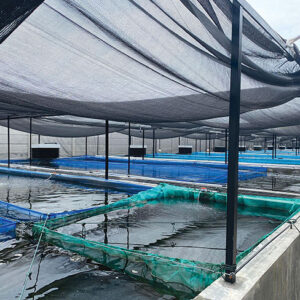
Features
Research
Breeding
Genetics Week
Rwanda’s fishless country
Rwanda hopes to set aquaculture blueprint for Central Africa
September 6, 2023 By Bob Atwiine
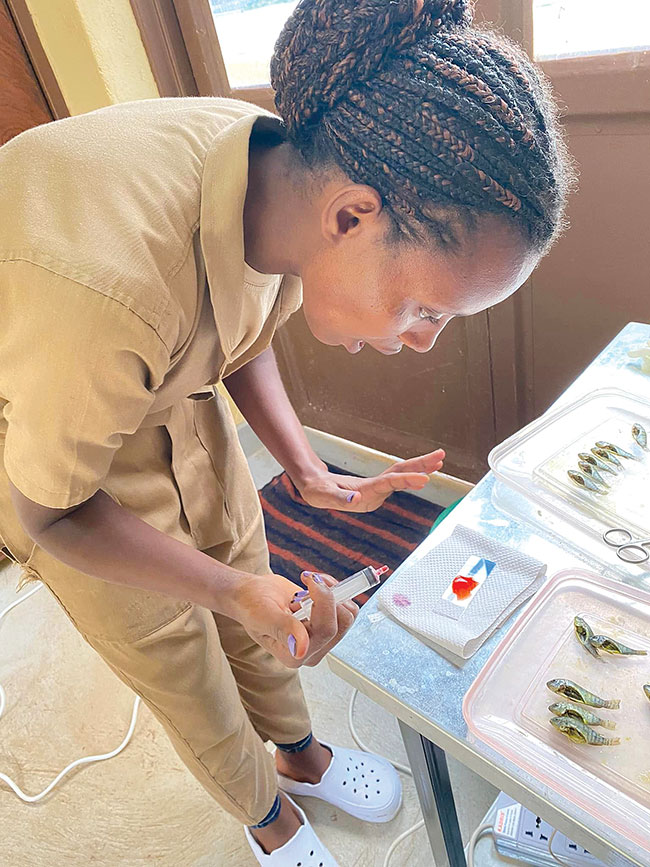 Aquaculture scientists at Gishenda Fish Farm are conducting genetic checks on Nile tilapia. In the middle is an indoor closed hatchery system at Lakeside Fish Farm in Bugesera district.
Photos: RWANDA ministry of agriculture & animal resources
Aquaculture scientists at Gishenda Fish Farm are conducting genetic checks on Nile tilapia. In the middle is an indoor closed hatchery system at Lakeside Fish Farm in Bugesera district.
Photos: RWANDA ministry of agriculture & animal resources For Rwanda, as with other Central African countries, fortunes are to be found in aquatic life; an equitable source of food available to all regardless of status.
Nevertheless, fish farming in this tiny Central African country is highly exposed to many factors, which for a long time, have hampered the production of enough fish.
The country boasts 101 lakes, 861 rivers and 860 marshlands though major fishing is carried out in only 24 of these lakes and four rivers, distributed in 15 districts. Despite having all these water bodies, these lakes and rivers have the least number of fish species, compared to those in the regional neighbours like Burundi, Uganda, Tanzania and the Democratic Republic of Congo.
Rwanda’s fish demand is expected to rise to 112,000 metric tonnes by 2024 but with only a few months remaining to hit the national target, it does not even produce half of the projected demand.
According to Uwutaze Solange, the deputy director general in charge of Animal Resources Research and Technology transfer at Rwanda’s Agriculture and Animal Resources Development Board, the country’s fish production in 2021 was 39,269 tonnes, of which 87 per cent was from fish capture and 13 per cent from farmed fish.
The major question is why with all these hundreds of lakes and rivers, Rwanda is grappling with fish deficit in order to certify its demand?
Over the years, several scientific research studies have been conducted and results show the problem is linked to topography.
Environmental constraints
Rwanda is hilly and mountainous, averaging elevation of 1,700 metres. It enjoys a moderate tropical climate due to its high altitude, with average annual temperatures of 20°C, which is low and unfavourable for most fish species to grow naturally.
According to the Auburn University study, Rwanda’s unusual temperatures make it “not the ideal place to do fish farming” because all the country’s waters are generally too cold for the warm water species and too warm for the cold water species.
Pond water temperatures are usually in the low twenties; soil pH is usually 4-5; and surface waters have total alkalinities of 10- 20 mg l-1 as CaCO3. The proportion of acid soil coverage is estimated at 45 per cent of the total 46 agricultural lands in Rwanda.
Thus, cool temperatures, acidic soil, and soft water pose challenges to fish culture in Rwanda, according to the study.
Oxygen shortage
Over the years, the country has witnessed mortalities, most especially on Lake Muhazi, where more than 10,000 fish in cages were found dead. Findings showed that they died from depletion of dissolved oxygen caused by water turnover, which triggers a deadly algal bloom that causes competition for oxygen consumed by the fish and the algae.
Scientists explain that the country’s deep waters contain no oxygen and every year, lakes experience a condition where the oxygen-less waters come up and mix with the surface water, killing almost all the fish in lakes including those in Lake Burera and Lake Ruhondo.
A study published in 2020 in the Rwanda Journal of Engineering, Science, Technology and Environment found that water in Lakes Burera and Ruhondo were also “unusable for drinking.”
Fewer fish species
Researchers also discovered that Rwanda has a minimal number of native fish species.
Dr. Karen Veverica from the Department of Fisheries and Allied Aquaculture at Auburn University in Alabama, USA published research that explains that Lake Kivu used to be part of the Nile River drainage, which used to drain up to Lake Edward in Uganda.
But when the Virunga Mountains formed (in the early part of the Pleistocene Epoch, relatively young), it changed the drainage of Lake Kivu to go to the south to Lake Tanganyika in Burundi and Tanzania.
This, according to Veverica’s findings, may have resulted in few new species that were naturally introduced in the lake due to its isolation. Thus, Rwanda has the fewest fish species compared with the neighbouring countries.
- Rwandan scientsists controlling tilapia sexes. (Photo: MINAGRI)
- An indoor closed hatchery system at Lakeside Fish Farm’ in Bugesera district. (Photo: MINAGRI)
- An worker at Lakeside Fish Farm in Rwamagana district showcases a mature Nile Tilapia.Rwanda’s GIFT is helping to provide new eonomic and livelihood opportunities throughout aquaculture value chain. (Photo: MINAGRI)
Government action
Several years ago, the Rwanda, Tanzania, and Burundi governments agreed to construct a hydropower dam at Rusumo Falls along the countries’ shared border. Scientists argued that the dam is one reason there are fewer fish species in Rwanda because it blocked the migration upstream.
The country’s aquaculture has been insignificant because of lack of infrastructure, resources, pond fertilization from livestock wastes. There are also inherent managerial weaknesses in the public sector with many dependent on handouts to subsistence farmer. The new model must be developed from scratch.
Rwanda’s new 2023-2035 Aquaculture Strategy aims to boost annual fish production through aquaculture from a paltry 39,269 tonnes to 127,000 metric tonnes by 2035. This initiative aims
to reduce undernourishment among the population by increasing the nation’s per capita consumption of 2.3 kilograms.
The new strategy is to produce farmed fish using three production systems such as earthen ponds on 324 hectares, floating cages comprising 59,390 cubic metres, and 41 dams with a total capacity of about 31.3 million cubic metres.
Private-public model
Despite all the scientific challenges, the country has developed a national strategy to prioritise sustainable fish farming and fish production by rolling out private-public model fish hatcheries across the country.
The government has mobilized and facilitated new investors in intensive fish farming and in tilapia hatcheries.
They include Radco Food Ltd. in Bugesera for pond farming, Kivu Choice Ltd. owning a tilapia hatchery in Gisaga (Kigembe) and cages in Nyamasheke for tilapia growout (production of table fish).
Akagera Management Company Ltd. in Kayonza has set up a modern tilapia hatchery and started intensive tilapia production in Recirculating Aquaculture System (RAS) run on solar power. Known as Gishanda Fish Farm, this Akagera project is funded in partnership between Akagera National Park (managed by African Parks), Food Tech Africa, and a consortium of Dutch private companies. This project is also supported in part by the governments of Rwanda and the Netherlands. It is also the country’s learning centre for aquaculture.
Gishanda is expected to produce one million to 1.5 million tilapia fingerlings annually, of which 110,000 will be retained for farm production. A high-quality strain of tilapia, the commercial scale of around one million fingerlings is meant to bolster the country’s aquaculture sector.
About 300,000 to 400,000 will then be used for restocking lakes in the region, generating locally viable sources of protein and economic growth, according to the management.
It has also established three catfish demo ponds on-site to teach household-level catfish farming to community members. Pond supplies and assistance will be provided to the community to develop catfish farming for nutritional and enterprise purposes.
Other new companies include 2CN Ltd. in Rutsiro for Cage Fish Farming, Edgard Enterprise in Rutsiro for cage fish farming and Great Lakes Africa in Karongi.
Solange Uwimana notes that these hatcheries will greatly increase the access and availability of quality fries and fingerlings, thereby enabling fish farmers to expand their existing operations.
- Officials from Rwandan ministry of agriculture inspecting hatchery jars at Lakeside Fish Farm in Bugesera district (Photo: MINAGRI)
- An aquaculture scientist conducting microchipping and recycling at Gishanda Fish Farm (Photo: MINAGRI)
- Lakeside Fish tilapia farm in Bugesera district (Photo: MINAGRI)
Cage farming
According to a report provided by the Ministry of Agriculture and Animal Resources Rwanda, to increase fish production, more efforts are being deployed to promote modern fish farming in cages, dams, tanks and ponds where about 43.7 million fingerlings were produced in 2021/2022 financial year.
The government through the Ministry of Agriculture has also deployed graduates from the University of Rwanda and other Israel- trained Rwandan students who acquired hands-on skills in aquaculture to help the government increase national ponds’ fish production from 30 kilograms per 100 square metres to 200 kg per 100 square metres.
These have since introduced Nile tilapia in 1,099 ponds across the country as it targets to produce 112,000 tonnes of fish every year by 2024.
The team has also trained hundreds of fish farmers on rice-fish integration, cage fish farming, tilapia hatchery and lake guardians.
The government early this year announced plans to commit more than US$16 million towards implementing a five-year project with funding from the Belgium government to boost aquaculture in the country.
This project is expected to start by improving and increasing fish feeds to reduce the high prices of feeds made from soya beans and maize. Currently, the country has only two factories able to produce feeds that are suitable for tilapia in the country.
This would also in turn address the issue of poor cash flow in the rural areas which initially hindered both purchase of inputs and sales of fish.
Investment in Aquaculture Research
Rwandan research scientists recently concluded a study on the effect of using different broodstock densities on the reproductive performance of Nile tilapia (Oreochromis nileticus). The objective was to evaluate the growth performance, survival rate and feed conversion ratio on introduced tilapia sourced from the Netherlands by Til-Aqua International Company and cultured in tanks to be distributed to local farmers.
The country has also conducted a study to make the production of maggot, feed formulation and feeding fish to study the effect of soybean meal replacement by black soldier fly larvae meal in Nile Tilapia diet to address the challenge of high costs of fish feeds imported from abroad.
This study has concluded that black soldier fly meal is considered as one of the best alternatives for partial or complete replacement of soybean meal in Nile tilapia diets. The government has started recommending the adoption of this animal protein source to fish farmers to sustainably produce cheap and nutritious fish feed capable to increasing yields and maximizing profits.
Uwutaze Solange, the deputy director general in charge of Animal Resources Research and Technology transfer at Rwanda Agriculture and Animal Resources Development Board, emphasizes that the government is working hard to make enabling policies and regulatory frameworks to ensure sustainable environments for development and realize full potential through collaboration with all stakeholders.
Print this page
Advertisement
- ViAqua preps to launch first product with $8.2M funding
- Idaho fish bags award for hatchery trout study
